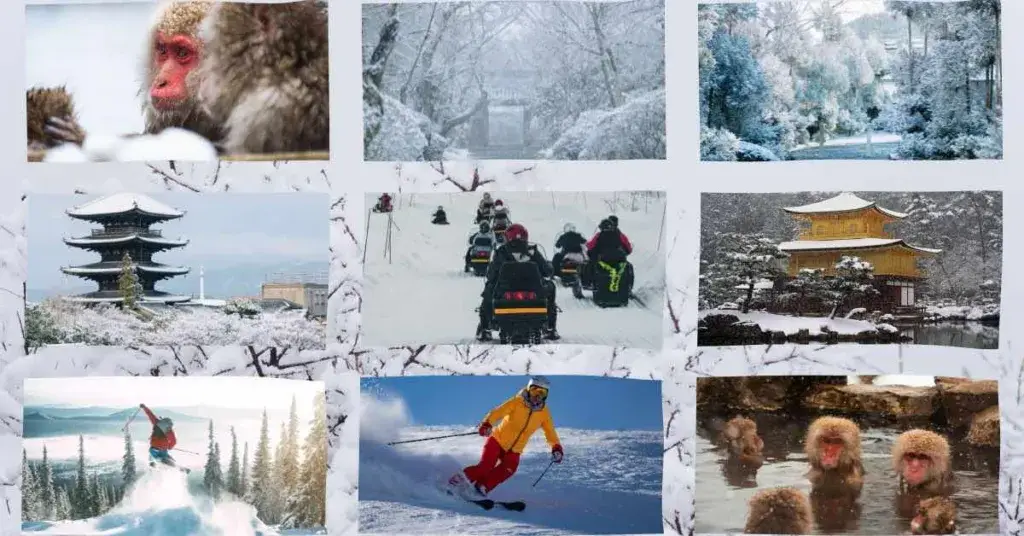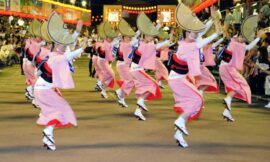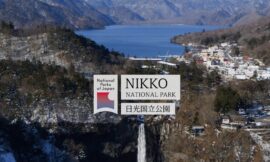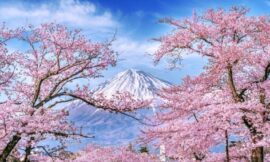Japan Ski Resorts | Winter Travel Guide: Best Snow Festivals & Onsen Getaways
Dive into Japan’s magical winter with this complete guide to the top Japan ski resorts, must-see snow festivals, relaxing onsen hot springs, and a 7-day itinerary with tips for finding the most photogenic winter wonderlands.
Why Travel to Japan in Winter?
From mid-December through February, Japan turns into a snow-draped wonderland perfect for winter lovers. Whether you’re carving powder in Niseko, soaking in a steamy mountain onsen, or admiring the dazzling lights of a snow festival, Japan’s winter charms are endless. Plus, the snow quality here—especially in Hokkaido and the Japanese Alps—is world-renowned for its dry, fluffy texture.

Top Japan Ski Resorts
- Niseko – Hokkaido
- Why go: Famous for light, fluffy powder snow, Niseko is Japan’s most international ski resort, with excellent terrain for all levels.
- Highlights: Night skiing, après-ski dining, English-friendly services.
- Top keywords: Niseko ski resort, Japan powder skiing, Hokkaido snow travel
- Hakuba Valley – Nagano
- Why go: A legacy of the 1998 Winter Olympics, Hakuba offers 10 interconnected resorts in the Japanese Alps, great for all skill levels.
- Highlights: Backcountry skiing, ski-in/ski-out lodges, and alpine views.
- Top keywords: Hakuba ski Japan, Nagano winter travel, Olympic ski resorts Japan
- Furano – Hokkaido
- Why go: A local favorite with fewer crowds than Niseko, Furano delivers top-tier powder, scenic beauty, and a charming town atmosphere.
- Highlights: Family-friendly slopes, hot springs, snowmobiling.
- Top keywords: Furano skiing, Hokkaido winter resorts, quiet ski Japan
- Nozawa Onsen – Nagano
- Why go: Combines skiing and traditional Japanese culture in one destination. Enjoy classic ryokans, cobblestone streets, and 13 free public onsens.
- Highlights: Village charm, local sake, and the Dosojin Fire Festival.
- Top keywords: Nozawa Onsen ski, Nagano snow village, Japan ski and onsen
- Zao Onsen – Yamagata
- Why go: Home of the famous “Snow Monsters” (juhyo) — frost-covered trees that create an otherworldly landscape.
- Highlights: Night skiing through juhyo forests, historic hot spring baths.
- Top keywords: Zao Onsen snow monsters, Tohoku ski resort, Japan winter wonderland
♨️ Winter Experiences Beyond the Slopes
- Soak in an Outdoor Onsen: Try places like Kusatsu, Nyuto, or Ginzan Onsen for unforgettable hot spring experiences surrounded by snow.
- See the Snow Monkeys in Jigokudani: Watch wild macaques relax in steaming natural baths in Nagano’s famous monkey park.
- Attend Winter Festivals:
- Sapporo Snow Festival (early February) – Giant snow and ice sculptures
- Otaru Snow Light Path Festival – Lantern-lit snow paths and canals
- Yokote Kamakura Festival – Traditional snow huts with candles inside
Must-See Winter Snow Festivals
- Sapporo Snow Festival (Hokkaido) – February
Towering snow sculptures, ice palaces, and nighttime illuminations. - Otaru Snow Light Path (Hokkaido) – February
Romantic canals lit with lanterns and snow carvings. - Yokote Kamakura Festival (Akita) – Mid-February
Igloo-style snow huts with candlelight and hot amazake drinks. - Lake Shikotsu Ice Festival (Hokkaido) – Late January to mid-February
Frozen water sculptures and colorful nighttime lights.
♨️ Best Onsen Towns for Winter Relaxation
- Kusatsu Onsen (Gunma): High sulfur springs, steamy streets, and traditional inns.
- Zao Onsen (Yamagata): Home of the famous “snow monsters” and excellent skiing.
- Kinosaki Onsen (Hyogo): Seven public bathhouses in a charming riverside town.
- Nyuto Onsen (Akita): Hidden, rustic baths surrounded by snow-covered forests.
7-Day Winter Itinerary: Japan Ski Resorts for Skiing, Snow Festivals & Onsen Bliss
🗓️ Day 1: Arrive in Sapporo (Hokkaido)
- Explore Sapporo Snow Festival (if visiting in February)
- Stroll through Odori Park, see giant snow sculptures
- Try local winter delicacies like miso ramen and Hokkaido crab
🗓️ Day 2: Day Trip to Otaru
- Visit the Otaru Snow Light Path Festival at dusk
- Photograph the canals lit by lanterns, drink warm sake at local izakayas
- Return to Sapporo for the night
🗓️ Day 3: Head to Niseko
- Travel to Niseko (2–3 hrs by train or bus)
- Afternoon skiing or snowboarding
- Relax in an onsen with mountain views
🗓️ Day 4: Full Ski Day + Nightlife in Niseko
- Hit the slopes at Grand Hirafu or Hanazono
- Explore Niseko village shops, then enjoy Japanese curry or hotpot
- Optional: Take night ski shots under lit runs
🗓️ Day 5: Travel to Zao Onsen
- Travel to Zao Onsen (Hokkaido → Yamagata via train/plane)
- Evening soak in a historic wooden bathhouse
🗓️ Day 6: Snow Monsters & Skiing at Zao
- Take the ropeway to see the Juhyo (snow monsters)
- Ski/snowboard the scenic tree-lined slopes
- Capture panoramic views of frost-covered forests
🗓️ Day 7: Onsen Retreat at Nyuto or Kusatsu
- Travel to Nyuto Onsen (Tohoku) or Kusatsu (Gunma)
- Enjoy a day of deep snow, forest hikes, and peaceful hot springs
- Spend the night in a ryokan with a kaiseki dinner
Top Winter Photography Spots & Tips
📍 Iconic Winter Photo Spots in Japan
- Snow Monkeys in Jigokudani (Nagano): Macaques bathing in natural hot springs
- Otaru Canal at Night (Hokkaido): Romantic snow and lantern reflections
- Mount Fuji from Lake Kawaguchi (Yamanashi): Best after fresh snowfall
- Zao’s Snow Monsters (Juhyo): Best at golden hour or under lights at night
- Sapporo Snow Festival Sculptures: Use wide-angle lenses for scale
- Nozawa Onsen Village: Atmospheric shots with snow falling on ryokan rooftops.
📸 Winter Photography Tips for Japan
- Shoot in Golden Hour for Magical Lighting
- Early morning or late afternoon provide soft, warm light that makes snow landscapes and mountain peaks glow.
- Tip: If shooting people (skiers, snowboarders, or even snow monkeys), golden hour lighting will enhance their features and add depth to the snow.
- Use a Polarizing Filter for Snow & Sky
- A polarizing filter helps reduce reflections from snow and water, making blue skies richer and snow details crisper.
- Helps eliminate glare from ski goggles or snow, keeping your shots clean.
- Capture the Snowy Landscape with Wide Angles
- Use a wide-angle lens (24mm or wider) to capture the vastness of snowy mountain vistas.
- Don’t just focus on the slopes—look for snow-covered trees, mountain peaks, and ski lifts to tell the story of the entire resort.
- Slow Shutter for Action Shots in Japan Ski Resorts
- To capture motion (skiers, snowboarders, or snowmobiles), use a slower shutter speed (around 1/250 to 1/500 sec).
- Tip: Experiment with panning (moving your camera along with the skier) for a dynamic effect.
- Night Photography: Capture Snowy Landscapes
- Use a tripod for stability, especially if shooting at night or in low-light conditions.
- Set your aperture around f/8 and your ISO as low as possible (to avoid noise) while adjusting your shutter speed based on the light levels.
- Shoot Snow Monkeys & Wildlife
- In Jigokudani Monkey Park, use a telephoto lens (70–200mm) to zoom in on the snow monkeys.
- Keep your distance and avoid disturbing the wildlife.
- Look for Detail Shots
- Capture the beauty of winter with close-ups of snowflakes on tree branches, ski tracks in the snow, or frost-covered lanterns.
What to Pack for Japan in Winter
- Waterproof boots and snow gear
- Layers: thermal base, insulated jacket, and outer shell
- Gloves, beanie, and scarf
- Portable hand warmers (kairo)
- Pocket Wi-Fi or SIM card for navigation
- IC card (Suica or Pasmo) for easy travel
🚅 Getting Around Japan in Winter
- Japan Rail Pass: Great value for long-distance travel between regions.
- Shinkansen (Bullet Train): Fast, reliable, and runs even in snowy conditions.
- Resort Shuttles: Many ski resorts offer direct shuttle buses from Tokyo, Sapporo, or airports.
✈️ Closest Airports to Major Ski Areas:
- Niseko/Furano: New Chitose Airport (CTS), Sapporo
- Hakuba/Nozawa/Zao: Narita (NRT), Haneda (HND), or Nagano’s Shinkansen line
- Luxury Ski Hotels: The Vale Niseko, Hakuba Tokyu Hotel, Zaborin Ryokan
- Traditional Ryokans: Takinoyu Ryokan (Zao), Ryokan Sakaya (Nozawa)
- Budget-friendly Lodges: Lodge Fujimien (Furano), K’s House Hakuba
Book early—accommodation fills up fast between late December and mid-February!
Additional Winter Travel Tips for Japan Ski Resorts
- Book Ski Passes in Advance: Japan’s ski resorts are popular during the winter months, especially over the New Year holiday and Chinese New Year. Book your lift tickets and accommodations early.
- Pack for Cold Weather: Layer your clothing to stay warm, and don’t forget waterproof outerwear and gloves.
- Consider Renting Gear: If you’re not bringing your own equipment, most resorts have rental shops.
- Onsen Etiquette: If you plan to visit onsens, make sure to follow Japanese onsen etiquette (i.e., wash thoroughly before entering the communal baths).
- Winter Food & Drinks: Warm up with local hot pot dishes, soba noodles, and hot sake after a day on the slopes.
Want a 10 days Winter Travel Itinerary?
📌 Sample Winter Itinerary: 10 Days in Japan
Day 1–3: Tokyo arrival & explore winter illuminations
Day 4–7: Hakuba skiing + hot spring visit
Day 8–9: Day trip to Jigokudani Snow Monkey Park
Day 10: Return to Tokyo or fly home from Nagano/Sapporo
Final Thoughts
Japan’s ski resorts offer an exceptional winter travel experience, blending world-class slopes with rich cultural experiences. Resorts like Niseko, Hakuba, and Nozawa Onsen attract skiers and snowboarders with their powder snow and diverse terrains. Beyond the slopes, visitors can unwind in traditional onsens (hot springs), offering the perfect contrast to the cold.
Japan’s hospitality, cuisine, and unique après-ski activities make it a prime destination for both adventure and relaxation. Whether you’re chasing powder or seeking rejuvenation, Japan’s winter resorts provide an unforgettable combination of outdoor thrills and serene cultural experiences. It’s a destination worth exploring for every traveler.
Plan your trip to Japan with the itinerary provided above to visit Japan ski resorts, onsen, and Japan’s Winter festival to make your visit to Japan mesmerizing.



